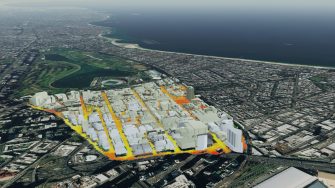The NSW Department of Planning and Environment in partnership with UNSW's High Performance Architecture team, led by Associate Professor Lan Ding, is set to commence the first phase of the Smart and Cool Spaces project following the signing of an agreement providing $483,000 funding.
The project’s goal is to establish a “National Heat Vulnerability Observatory” (NaHVO) and will commence with a pilot in Maitland and Dubbo, with a view to scaling the project to integrate Australia’s largest cities.
Urban overheating already presents a challenge for Australia’s cities, and those challenges will increase as temperatures rise. It is expected that Sydney and Melbourne will have 50°C+ summer days in the near future, with Western Sydney already reaching 48.9°C in January 2020.
“The impacts of urban heat vulnerability are acknowledged as a significant issue for the future of Australian cities across all levels of government,’ explains A/Prof. Ding. “The impacts include deaths and emergency admissions from heat waves, increased energy and water consumption, and equity issues for vulnerable populations.”
While there are currently a range of mitigation and adaptation interventions that can be used to reduce the impacts of urban overheating in the built environment, there are challenges to their implementation due to lack of consistent data and the unique environments of different cities and towns.
“The project is part of the NSW Government Digital Restart Fund, which develops rigorous national datasets and an innovative, robust and consistent methodology to report and measure the heat vulnerability and cooling potential of Australia’s cities,” says A/Prof. Ding.
Ultimately NaHVO will provide data that will: help identify specific vulnerabilities in cities and towns; provide the ability to monitor heat vulnerability and cooling potential trends; provide modelling tools for scenario testing; and be interoperable with the NSW Digital Twin and other urban networks and government data platforms.
“This project will generate significant public benefit,’ says A/Prof. Ding. “It’s important to be able to plan for resilient and smart places and communities to combat climate change and its serious impacts.”
“We are very excited to be part of this project,” says Professor Claire Annesley, Dean of the Faculty of Arts, Design & Architecture. “As a university UNSW is committed to developing solutions to the problems facing our cities and our planet. Climate change and its effects on urban communities is one such problem and the Smart and Cool Places project will ultimately enable heat mitigating solutions to be effectively applied to urban environments. It is a great example of the important ways our researchers can lead positive change by collaborating with government, industry and communities.”

